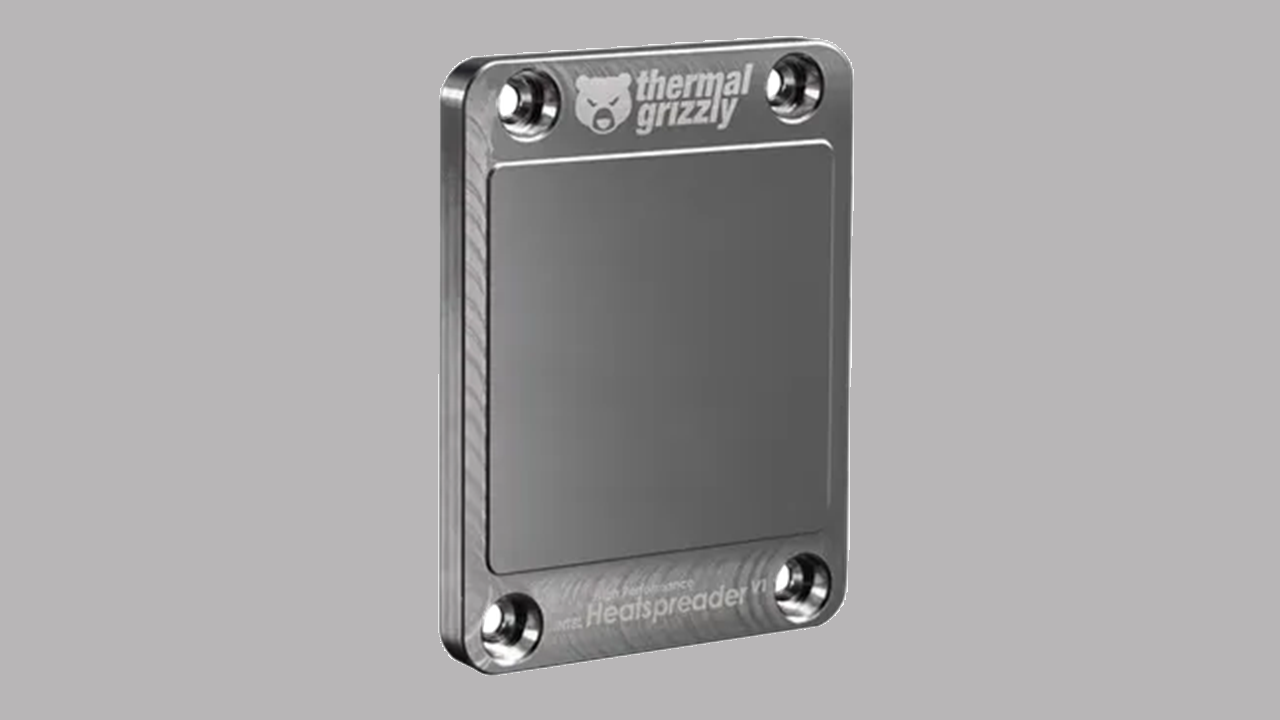Thermal Grizzly's new heatspreader claimed to lower CPU temperatures by nearly 15 degrees Celsius
Another option for enthusiasts who dare to delid.

Users of Intel CPUs spanning 12th Gen to 14th Gen who dare to delid will soon be able to enjoy the cooling benefits of Thermal Grizzly's High Performance Heatspreader (HPHS) V1. Compared to Intel's stock heatspreaders, the Thermal Grizzly Intel HPHS V1 has a 207% larger surface area and is diamond-milled for an even flatter surface. But what does all of this really mean for performance?
According to tests done by Thermal Grizzly using a Core i6-14600K in a custom loop liquid cooling configuration with a Watercool MO-RA3, Thermal Grizzly's Heatspreader reduces temperatures by 14.8 degrees Celsius compared to a standard CPU IHS (integrated heat spreader). This is a significant improvement, but of course, only one that can be achieved in similarly high-end cooling conditions (heatspreader replacement, liquid metal cooling, etc).
This latest release from Thermal Grizzly follows in the steps of similar moves by other manufacturers who have attempted to address the cooling shortcomings of the latest Intel desktop CPUs. For example, the EK-Nucleus AIO is claimed to improve temperatures by about the same amount, but is only intended for fully delidded CPUs. Back with 12th Gen, Thermal Grizzly also launched a CPU contact frame that reduced temperatures by 10 degrees Celsius due to design flaws on Intel's end.
Besides a new heatspreader, Thermal Grizzly's news release also briefly discusses its Intel Mycro Direct-Die V1 AIO liquid cooler, which is similar to the EK-Nucleus AIO we discussed prior. The Intel Mycro Direct Die AIO from Thermal Grizzly was also tested to achieve temperature decreases of 17.2 degrees Celsius than a "comparison cooler", though that comparison cooler isn't actually specified.
Both new TG devices tested were done so in controlled but extreme conditions, with delidded CPUs, liquid metal cooling, and the like placing these products well outside the wheelhouse of your average PC builder. Thermal Grizzly's high-performance AIO and heatspreader are both already available on its site, though, and builders who wait a few more weeks can also snag an RGB version of the full cooler, should you please. Moreover, the firm is likely to address the AMD AM5 market with something similar to the HPHS V1 in due course.
Correction, May 22, 2024: This article previously misstated the CPU in Thermal Grizzly's custom loop. We regret the error.
Get Tom's Hardware's best news and in-depth reviews, straight to your inbox.

Christopher Harper has been a successful freelance tech writer specializing in PC hardware and gaming since 2015, and ghostwrote for various B2B clients in High School before that. Outside of work, Christopher is best known to friends and rivals as an active competitive player in various eSports (particularly fighting games and arena shooters) and a purveyor of music ranging from Jimi Hendrix to Killer Mike to the Sonic Adventure 2 soundtrack.
-
das_stig The price we are paying for CPU's why Intel and AMD just cant use decent thermal materials and stop cutting corners to say a few pennies on the BOM and make the product as it should be. Myself and probably most customers, would be more than happy to cover the costs to get extra cooling headroom.Reply -
Reply
Users of Intel CPUs spanning 12th Gen to 14th Gen who dare to delid will soon be able to enjoy the cooling benefits of Thermal Grizzly's High Performance Heatspreader (HSPS) V1. Compared to Intel's stock heatspreaders, the Thermal Grizzly Intel HSPS V1
It is Intel High Performance Heatspreader V1 HPHS. Not HSPS. Correct the typo.
According to tests done by Thermal Grizzly using a Core i9-13900KS in a custom loop liquid cooling configuration with a Watercool MO-RA3, Thermal Grizzly's Heatspreader reduces temperatures by 14.8 degrees Celsius compared to a standard CPU IHS (integrated heat spreader).
Wrong !
An Intel Core i5-14600K was tested at a clock speed of 5.6 GHz and a core voltage of 1.4 volts (vCore) in Cinebench R23 in a custom loop with a Watercool MO-RA3, including four Noctua 200 mm fans .
With the Intel High Performance Heatspreader V1, this average could be reduced by 14.8 °C to 77.3 degrees.
The 13900KS was tested using the Intel Mycro Direct-Die V1 instead.
Besides a new heatspreader, Thermal Grizzly's news release also briefly discusses its Intel Mycro Direct-Die V1 AIO liquid cooler, which is similar to the EK-Nucleus AIO we discussed prior.
Eh ? Can we call it an AIO though ?
https://www.thermal-grizzly.com/en/intel-mycro-direct-die/s-tg-my-dd-i-v1 -
bit_user Reply
It's not only about cost, but I'm sure that's a big part of it. These CPUs also need to withstand a wide range of environmental and operational conditions for extended periods of time. I'm sure that feeds into the tolerances they build into their products.das_stig said:The price we are paying for CPU's why Intel and AMD just cant use decent thermal materials and stop cutting corners to say a few pennies on the BOM and make the product as it should be.
However, I would agree that premium SKUs, like Intel's KS models, should probably go an extra step in using better materials and tighter tolerances. -
AngelusF Reply
Why not just sell the KS-class CPUs unlidded?bit_user said:However, I would agree that premium SKUs, like Intel's KS models, should probably go an extra step in using better materials and tighter tolerances. -
Eximo Reply
Oh that is just inviting disaster. With the Z difference, someone would try and use it without a direct die capable cooler and cook it.AngelusF said:Why not just sell the KS-class CPUs unlidded?
Also, we used to have naked die CPUs. It was quite common for them to get chipped and broken by CPU cooler installation. -
TerryLaze Reply
So the intel HS was at 92C with 1.4V and 5.6Ghz leaving a good 10% headroom before even starting to throttle...so it's a useless product and only there to sell people up on worthless things.Metal Messiah. said:An Intel Core i5-14600K was tested at a clock speed of 5.6 GHz and a core voltage of 1.4 volts (vCore) in Cinebench R23 in a custom loop with a Watercool MO-RA3, including four Noctua 200 mm fans .
With the Intel High Performance Heatspreader V1, this average could be reduced by 14.8 °C to 77.3 degrees.
Why the heck didn't they test the 14900k ? -
Amdlova My 13600t can enter on windows before lock up with no heatsink:)Reply
These shinigam tech can't catch me anymore. -
ReplyTerryLaze said:Why the heck didn't they test the 14900k ?
Not sure why they didn't go for the flagship SKU. I guess only the TG team who benchmarked the CPU can answer this more clearly. -
Dementoss Reply
So not impartial then...Admin said:According to tests done by Thermal Grizzly
Also, they are using a massive radiator, that accommodates nine 14cm fans. -
TerryLaze Reply
They probably did but the difference was smaller, just my guess though.Metal Messiah. said:Not sure why they didn't go for the flagship SKU. I guess only the TG team who benchmarked the CPU can answer this more clearly.